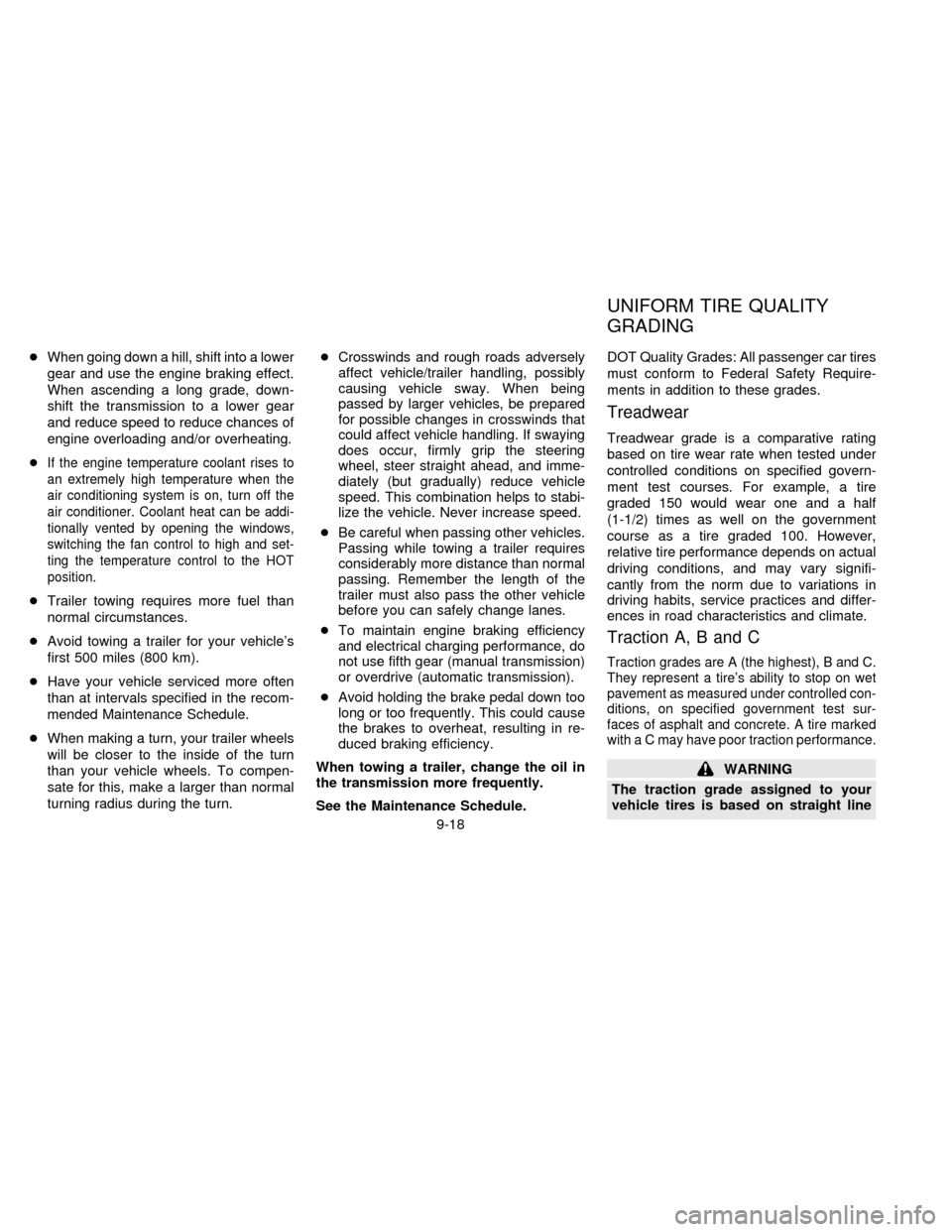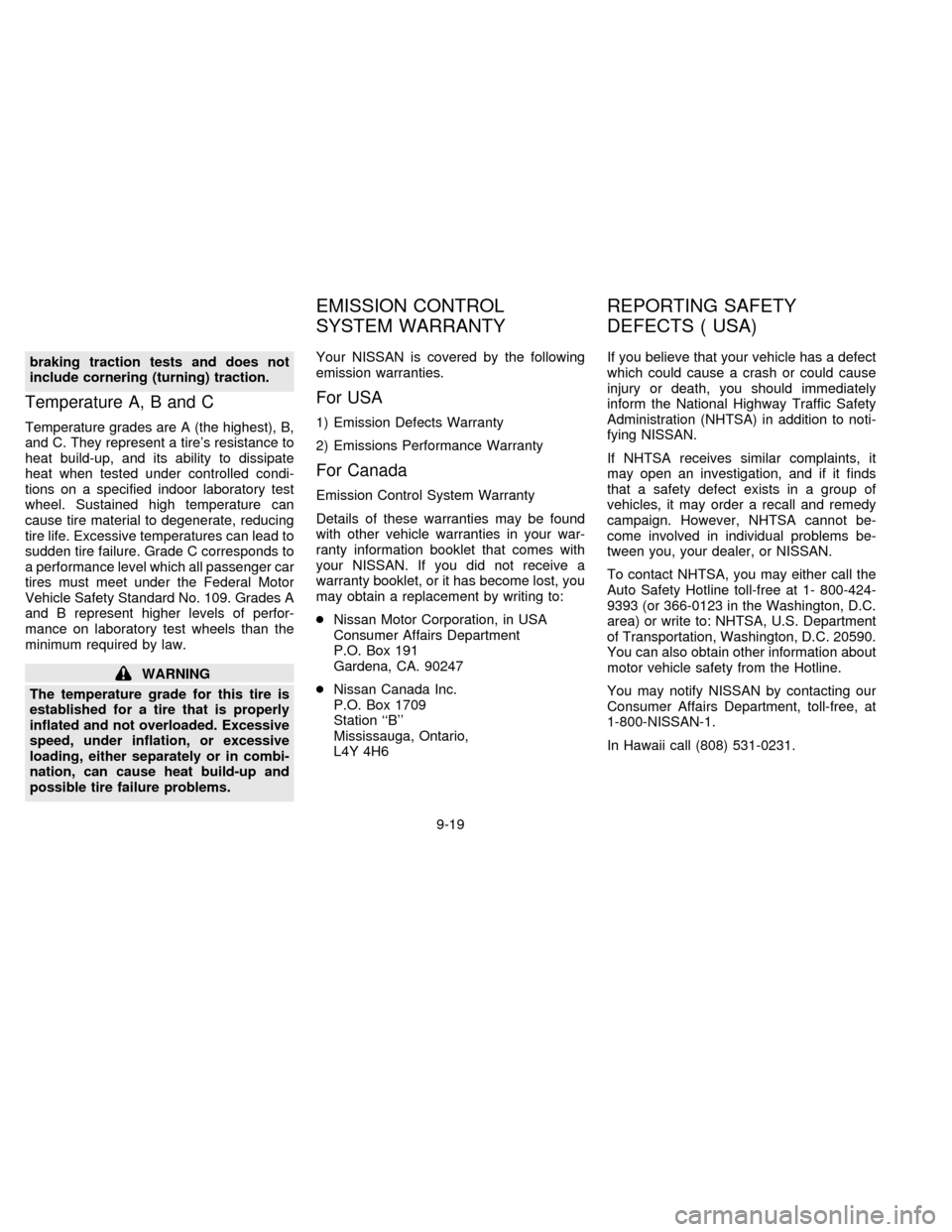1996 NISSAN SENTRA Wheel
[x] Cancel search: WheelPage 175 of 191

200SX SENTRA Wheel
Dimension
Road wheel
139steel w/center
capÐ E* 13ý5J
139steel w/full cover S XE, GXE 13 ý 5J
149aluminum alloy SE GLE 14 x 5.5JJ
159aluminum alloy SE-R Ð 15 ý 6JJ
Offset in (mm) 1.57 (40)
Conventional tire
size
P155/80R13 E* 13 x 5J
P175/70R13 S XE, GXE 13 x 5J
P175/65R14 SE GLE 14 x 5.5JJ
P195/55R15 SE-R 15 x 6JJ
Spare tire size
T115/70D14 S, SE E*, XE, GXE,
GLE14ý4T
T135/70D15 SE-R 15 x 4T
*: base model in Canada
200SX SENTRA
Overall length in (mm) 169.8 (4,313) 170.1 (4,321)
Overall width in (mm) 66.6 (1,692) 66.6 (1,692)
Overall height in (mm) 54.2 (1,377) 54.5 (1,384)
Front tread
13-inch in (mm) 58.3 (1,481) 58.3 (1,481)
14/15-inch in (mm) 57.9 (1,471) 57.9 (1,471)
Rear tread
13-inch in (mm) 56.9 (1,445) 56.9 (1,445)
14/15-inch in (mm) 56.5 (1,435) 56.5 (1,435)
Wheelbase in (mm) 99.8 (2,535) 99.8 (2,535)
Gross vehicle weight
rating lb (kg)
See the ``F.M.V.S.S. certification
label'' on the driver's side door
pillar. Gross axle weight rating
Front lb (kg)
Rear lb (kg)
WHEEL/TIRE SIZE DIMENSIONS AND WEIGHTS
9-10
ZX
Page 182 of 191

After the hitch is removed, seal the bolt
holes to prevent exhaust fumes, water
or dust from entering the passenger
compartment.
cRegularly check that all hitch mounting
bolts are securely mounted.
Tire pressures
cWhen towing a trailer, inflate the vehicle
tires to the recommended cold tire pres-
sure indicated on the tire placard (lo-
cated on the driver side center pillar.)
cTrailer tire condition, size, load rating
and proper inflation pressure should be
in accordance with the trailer and tire
manufacturers' specifications.
Safety chain
Always use a suitable chain between your
vehicle and the trailer. The chain should be
crossed and should be attached to the hitch,
not to the vehicle bumper or axle. Be sure to
leave enough slack in the chain to permit
turning corners.
Trailer lights
Trailer lights should comply with federal
and/ or local regulations. When wiring thevehicle for towing, connect the stop and tail
light pickup into the vehicle electrical circuit.
Trailer brakes
If your trailer is equipped with a braking
system, make sure it conforms to federal
and/or local regulations and that it is prop-
erly installed.
CAUTION
Never connect a trailer brake system
directly to the vehicle brake system.
Pre-towing tips
cBe certain your vehicle maintains a level
position when a loaded and/or unloaded
trailer is hitched. Do not drive the vehicle if
it has an abnormal nose-up or nose- down
condition; check for improper tongue load,
overload, worn suspension or other pos-
sible causes of either condition.
cAlways secure items in the trailer to
prevent load shifts while driving.
cBe certain your rear view mirrors con-
form to all federal, state or local regula-
tions. If not, install any mirrors required
for towing before driving the vehicle.
Trailer towing tips
In order to gain skill and an understanding
of the vehicle's behavior, you should prac-
tice turning, stopping and backing up in an
area which is free from traffic. Steering,
stability, and braking performance are
somewhat different than under normal driv-
ing conditions.
cAlways secure items in the trailer to
prevent load shift while driving.
c
Avoid abrupt starts, acceleration or stops.
cAvoid sharp turns or lane changes.
cAlways drive your vehicle at a moderate
speed.
c
Always block the wheels on both vehicle
and trailer when parking. Parking on a
slope is not recommended; however, if
you must do so, and if your vehicle is
equipped with automatic transmission,
first block the wheels and apply the park-
ing brake, and then move the transmis-
sion shift lever into the P position. If you
move the shift lever to the P position
before blocking the wheels and applying
the parking brake, transmission damage
could occur.
9-17
ZX
Page 183 of 191

cWhen going down a hill, shift into a lower
gear and use the engine braking effect.
When ascending a long grade, down-
shift the transmission to a lower gear
and reduce speed to reduce chances of
engine overloading and/or overheating.
c
If the engine temperature coolant rises to
an extremely high temperature when the
air conditioning system is on, turn off the
air conditioner. Coolant heat can be addi-
tionally vented by opening the windows,
switching the fan control to high and set-
ting the temperature control to the HOT
position.
cTrailer towing requires more fuel than
normal circumstances.
cAvoid towing a trailer for your vehicle's
first 500 miles (800 km).
cHave your vehicle serviced more often
than at intervals specified in the recom-
mended Maintenance Schedule.
cWhen making a turn, your trailer wheels
will be closer to the inside of the turn
than your vehicle wheels. To compen-
sate for this, make a larger than normal
turning radius during the turn.cCrosswinds and rough roads adversely
affect vehicle/trailer handling, possibly
causing vehicle sway. When being
passed by larger vehicles, be prepared
for possible changes in crosswinds that
could affect vehicle handling. If swaying
does occur, firmly grip the steering
wheel, steer straight ahead, and imme-
diately (but gradually) reduce vehicle
speed. This combination helps to stabi-
lize the vehicle. Never increase speed.
cBe careful when passing other vehicles.
Passing while towing a trailer requires
considerably more distance than normal
passing. Remember the length of the
trailer must also pass the other vehicle
before you can safely change lanes.
cTo maintain engine braking efficiency
and electrical charging performance, do
not use fifth gear (manual transmission)
or overdrive (automatic transmission).
cAvoid holding the brake pedal down too
long or too frequently. This could cause
the brakes to overheat, resulting in re-
duced braking efficiency.
When towing a trailer, change the oil in
the transmission more frequently.
See the Maintenance Schedule.DOT Quality Grades: All passenger car tires
must conform to Federal Safety Require-
ments in addition to these grades.
Treadwear
Treadwear grade is a comparative rating
based on tire wear rate when tested under
controlled conditions on specified govern-
ment test courses. For example, a tire
graded 150 would wear one and a half
(1-1/2) times as well on the government
course as a tire graded 100. However,
relative tire performance depends on actual
driving conditions, and may vary signifi-
cantly from the norm due to variations in
driving habits, service practices and differ-
ences in road characteristics and climate.
Traction A, B and C
Traction grades are A (the highest), B and C.
They represent a tire's ability to stop on wet
pavement as measured under controlled con-
ditions, on specified government test sur-
faces of asphalt and concrete. A tire marked
with a C may have poor traction performance.
WARNING
The traction grade assigned to your
vehicle tires is based on straight line
UNIFORM TIRE QUALITY
GRADING
9-18
ZX
Page 184 of 191

braking traction tests and does not
include cornering (turning) traction.
Temperature A, B and C
Temperature grades are A (the highest), B,
and C. They represent a tire's resistance to
heat build-up, and its ability to dissipate
heat when tested under controlled condi-
tions on a specified indoor laboratory test
wheel. Sustained high temperature can
cause tire material to degenerate, reducing
tire life. Excessive temperatures can lead to
sudden tire failure. Grade C corresponds to
a performance level which all passenger car
tires must meet under the Federal Motor
Vehicle Safety Standard No. 109. Grades A
and B represent higher levels of perfor-
mance on laboratory test wheels than the
minimum required by law.
WARNING
The temperature grade for this tire is
established for a tire that is properly
inflated and not overloaded. Excessive
speed, under inflation, or excessive
loading, either separately or in combi-
nation, can cause heat build-up and
possible tire failure problems.Your NISSAN is covered by the following
emission warranties.
For USA
1) Emission Defects Warranty
2) Emissions Performance Warranty
For Canada
Emission Control System Warranty
Details of these warranties may be found
with other vehicle warranties in your war-
ranty information booklet that comes with
your NISSAN. If you did not receive a
warranty booklet, or it has become lost, you
may obtain a replacement by writing to:
cNissan Motor Corporation, in USA
Consumer Affairs Department
P.O. Box 191
Gardena, CA. 90247
cNissan Canada Inc.
P.O. Box 1709
Station ``B''
Mississauga, Ontario,
L4Y 4H6If you believe that your vehicle has a defect
which could cause a crash or could cause
injury or death, you should immediately
inform the National Highway Traffic Safety
Administration (NHTSA) in addition to noti-
fying NISSAN.
If NHTSA receives similar complaints, it
may open an investigation, and if it finds
that a safety defect exists in a group of
vehicles, it may order a recall and remedy
campaign. However, NHTSA cannot be-
come involved in individual problems be-
tween you, your dealer, or NISSAN.
To contact NHTSA, you may either call the
Auto Safety Hotline toll-free at 1- 800-424-
9393 (or 366-0123 in the Washington, D.C.
area) or write to: NHTSA, U.S. Department
of Transportation, Washington, D.C. 20590.
You can also obtain other information about
motor vehicle safety from the Hotline.
You may notify NISSAN by contacting our
Consumer Affairs Department, toll-free, at
1-800-NISSAN-1.
In Hawaii call (808) 531-0231.
EMISSION CONTROL
SYSTEM WARRANTYREPORTING SAFETY
DEFECTS ( USA)
9-19
ZX
Page 189 of 191

Precautions when starting and driving ... 4-2
Push starting ................................................ 5-8
Q
Quick reference (See gas station information)
R
Radio
AM-FM radio ......................................... 3-11
AM-FM radio with cassette player ........ 3-13
CB radio or car phone .......................... 3-18
Rear seat ................................................... 2-15
Rear window defogger switch ................... 1-10
Refrigerant recommendation ....................... 9-8
Registering your vehicle in
another country .......................................... 9-11
Remote keyless entry system (See multi-
remote control system)
Reporting safety defects (USA) ................. 9-19
S
Safety
Child safety rear door lock ..................... 2-7
Reporting safety defects (USA) ............ 9-19
Seat adjustment ......................................... 2-13
Seat belt
Precautions on seat belt usage............ 2-22
Seat belt extenders .............................. 2-27Seat belt maintenance.......................... 2-27
Seat belts.............................................. 2-22
Shoulder belt height adjustment ........... 2-25
2-point type without retractor
(rear center lap belt) ............................. 2-26
3-point type with retractor..................... 2-23
Seats
Front seats............................................ 2-13
Rear seat .............................................. 2-15
Service manual order form ........................ 9-20
Shifting ......................................................... 4-7
Spark plug replacement............................. 7-18
Speedometer ............................................... 1-3
SRS warning label ..................................... 2-20
Starting
Before starting the engine ...................... 4-5
Jump starting .......................................... 5-7
Precautions when starting and driving ... 4-2
Push starting........................................... 5-8
Starting the engine ............................... 4-11
Steering
Power steering fluid .............................. 7-13
Tilting steering wheel............................ 2-34
Sun roof ..................................................... 1-16
Supplemental restraint system
(Air bag system) (If so equipped) .............. 2-15
Switch
Automatic power window switch .......... 1-16
Front fog light switch ............................ 1-12
Hazard warning flasher switch ............. 1-13
Headlight and turn signal switch .......... 1-11
Ignition switch ......................................... 4-4Overdrive switch ..................................... 4-8
Rear window defogger switch .............. 1-10
Windshield wiper and washer switch ..... 1-9
T
Tachometer .................................................. 1-3
Theft warning ............................................... 1-8
Three way catalyst....................................... 4-2
Tilting front seat ......................................... 2-14
Tilting steering wheel ................................. 2-34
Timing chain ................................................ 9-9
Tire
Flat tire.................................................... 5-2
Tire chains ............................................ 7-33
Tire placard........................................... 9-13
Tire pressure ........................................ 7-32
Tire rotation .......................................... 7-33
Types of tires ........................................ 7-32
Uniform tire quality grading .................. 9-18
Wheel/tire size ...................................... 9-10
Wheels and tires................................... 7-32
Towing
Tow truck towing .................................. 5-10
Trailer towing ........................................ 9-15
Towing load/specification chart ............ 9-16
Transmission
Automatic transmission fluid ................. 7-11
Driving with automatic
transmission............................................ 4-6
10-4
ZX
Page 190 of 191

Driving with manual transmission ........... 4-9
Travel (See registering your vehicle in
another country)
Trip odometer .............................................. 1-3
Trunk lid lock operation ............................... 2-9
Trunk light .................................................. 1-17
U
Uniform tire quality grading ....................... 9-18
V
Vanity mirror .............................................. 2-35
Vehicle dimensions and weights ............... 9-10
Vehicle identification
Vehicle identification number
(chassis number) .................................. 9-11
Vehicle identification number plate ...... 9-11
Vehicle loading information ....................... 9-14
Vehicle recovery ........................................ 5-11
Ventilators .................................................... 3-2W
Warning
Air bag warning light............................. 2-20
Hazard warning flasher switch ............. 1-13
Theft warning .......................................... 1-8
Warning/indicator lights and chimes ...... 1-5
Wheel/tire size ........................................... 9-10
Wheels and tires ........................................ 7-32
Window washer fluid.................................. 7-14
Windows
Locking passengers' windows .............. 1-15
Rear power windows ............................ 1-16
Manual .................................................. 1-15
Power windows..................................... 1-15
Wiper
Windshield wiper and washer switch ..... 1-9
Wiper blades......................................... 7-20
10-5
ZX